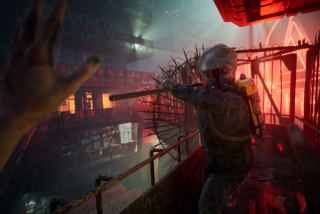Xbox Gets Its Wings With ‘Halo’
- Share via
One of the most highly anticipated games for Microsoft Corp.’s Xbox console is “Halo,” a first-person action game developed by Bungie Software, a studio acquired by Microsoft a year ago.
Microsoft is betting that “Halo” will be the “killer app” for its new console, being released today in U.S. stores. The game was initially designed for the personal computer. Turning it into a console game took work--and faith. Some developers believe that first-person action games that require quick reflexes--so-called twitch games--work best on a PC, not a console. The reason: Console controllers typically don’t have enough buttons to let players quickly maneuver in a three-dimensional environment and switch through and fire numerous weapons.
Jason Jones, co-founder of Bungie, said the development team took months to map game play to the Xbox controller. The result, critics say, is a fluid game with nonstop action.
Question: Why is the controller such a big deal?
Answer: People are just used to controlling games a certain way. Last year, we stopped using our mice and keyboards. It took us months to get used to it. But we came up with some ways to help players. When you’re aiming at something, for example, the game actually slows down the speed at which you look at the target. That helps you look and aim correctly. What we did was have the console watch what you’re trying to do. It’s really fun watching people who have never played the game. They don’t notice that. As soon as they look at something, the game slows down. There is a lot of work going on behind the scenes when you’re pushing those buttons or joysticks. It’s basically doing a lot of [artificial intelligence] for you.
Q: The Xbox is the first game console that comes with a substantial hard drive. How do you take advantage of it?
A: We did this thing where your progress is constantly saved without you knowing it. With other games, you have to stop to save the game. We can do it automatically on the hard drive. People can play the game for hours without having to figure out how to save the game.
We also have a whole lot of content when you start playing that we page off the hard drive. That way, we can access that content 10 times faster than if we had to read it off the disc. Say you’re standing outside. Then you run inside to another room. We can render environments so much faster because we’re pulling the data off the hard drive. On a traditional console, when you’re moving from one scene to another, there would be a loading screen, or the game would fade to black while the machine reads data off the disc.
Q: What was the design goal for “Halo?”
A: We really wanted to concentrate on that core experience. We wanted to make the second-to-second experience fun. So we gave the player a lot of tools. He has a lot of choices of what he can do at any given time. And it was important that you never got jerked out of the game. You never got stuck. You never had to navigate through the save game. And you never had to figure out what it was you needed to do next. We wanted that action to be nonstop.
Q: Some games are so open-ended that players sometimes get lost. Others are so well-defined that players feel like they’re being herded. What’s your philosophy?
A: Being open-ended was really important. In any situation in “Halo,” there are a lot of ways to approach the situation. You’ve always got a lot of choices, from the direction you go to the vehicles you use to whether or not you get help from the other characters. There are people who play the same environment over again because they want to try a different approach. Of course, you can make it so open-ended that people don’t know what to do. You always have to make sure the player knows where to go and what to do next. It’s a huge challenge in designing games.
Q: How do you guide players then?
A: You play the entire game with this [artificial intelligence, or AI, character] uploaded in your battle armor. The AI is named Cortana, and she’ll say things like “We’ll have to go here to rescue people.” Cortana follows you through the game, giving you advice, giving you background information, making fun of you. But sometimes, you have to open things a little more. There’s a point in the game where we deliberately create chaos and take away some of the tools that guide you. We wanted you to feel everything is going down the tubes.
*
Alex Pham covers the video game industry. She can be reached at alex.pham@latimes.com.






